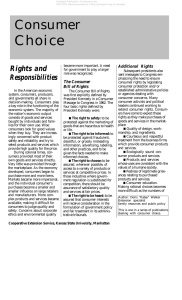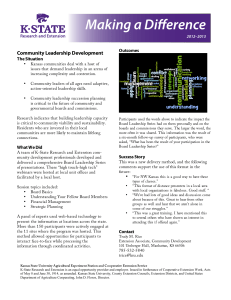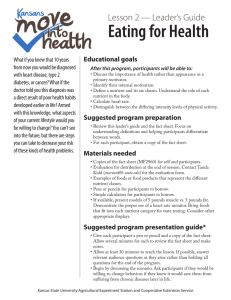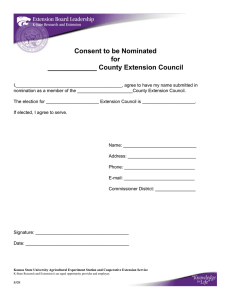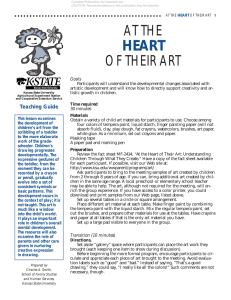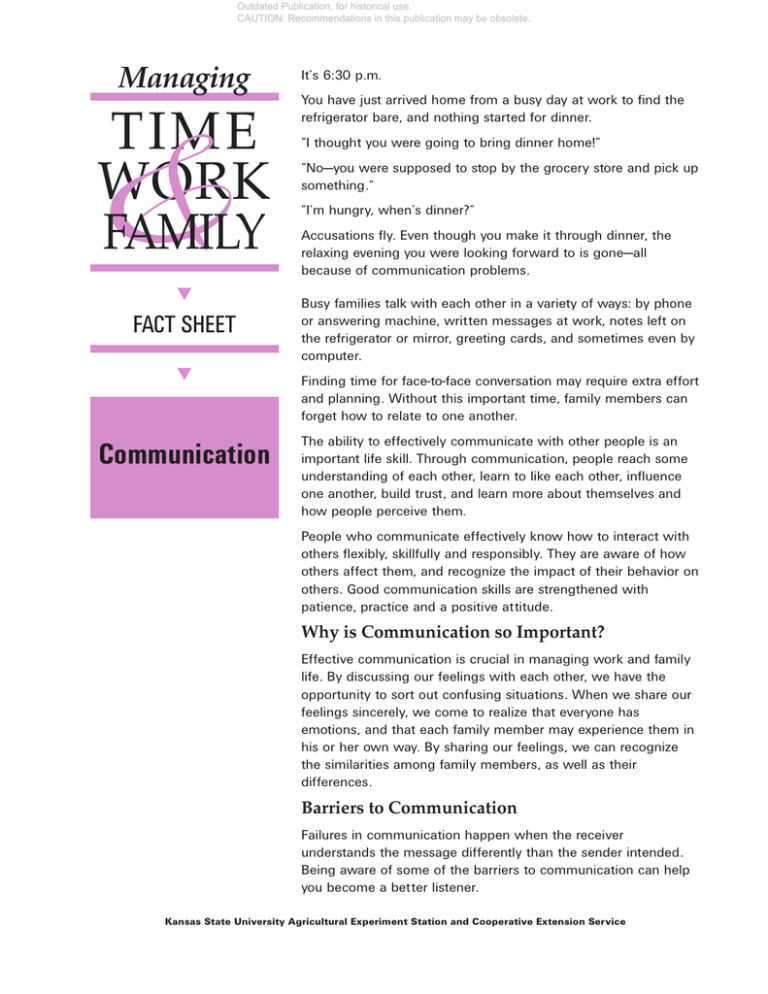
Outdated Publication, for historical use.
CAUTION: Recommendations in this publication may be obsolete.
Managing
TIME
WORK
FAMILY
&
▼
FACT SHEET
▼
Communication
It’s 6:30 p.m.
You have just arrived home from a busy day at work to find the
refrigerator bare, and nothing started for dinner.
“I thought you were going to bring dinner home!”
“No—you were supposed to stop by the grocery store and pick up
something.”
“I’m hungry, when’s dinner?”
Accusations fly. Even though you make it through dinner, the
relaxing evening you were looking forward to is gone—all
because of communication problems.
Busy families talk with each other in a variety of ways: by phone
or answering machine, written messages at work, notes left on
the refrigerator or mirror, greeting cards, and sometimes even by
computer.
Finding time for face-to-face conversation may require extra effort
and planning. Without this important time, family members can
forget how to relate to one another.
The ability to effectively communicate with other people is an
important life skill. Through communication, people reach some
understanding of each other, learn to like each other, influence
one another, build trust, and learn more about themselves and
how people perceive them.
People who communicate effectively know how to interact with
others flexibly, skillfully and responsibly. They are aware of how
others affect them, and recognize the impact of their behavior on
others. Good communication skills are strengthened with
patience, practice and a positive attitude.
Why is Communication so Important?
Effective communication is crucial in managing work and family
life. By discussing our feelings with each other, we have the
opportunity to sort out confusing situations. When we share our
feelings sincerely, we come to realize that everyone has
emotions, and that each family member may experience them in
his or her own way. By sharing our feelings, we can recognize
the similarities among family members, as well as their
differences.
Barriers to Communication
Failures in communication happen when the receiver
understands the message differently than the sender intended.
Being aware of some of the barriers to communication can help
you become a better listener.
1
Kansas State University Agricultural Experiment Station and Cooperative Extension Service
Outdated Publication, for historical use.
CAUTION: Recommendations in this publication may be obsolete.
Nonverbal messages
often speak louder than
the spoken word. Consider
the teen who comes in
late from a date. The
expression on the parent’s
face will probably prepare
him or her for the
unpleasant reception that
follows—even before the
first word is ever spoken.
Behaviors which make communication difficult include:
• Listening with “half an ear.” Often we are busy doing other
things and only give part of our attention to what is being
said.
• Acting as judge and jury instead of listening to the whole
story. We become so intent on making a quick decision about
the action that we do not hear the complete story.
• Tuning out ideas that we do not agree with. We do not allow
ourselves to listen because we “know” we will not agree.
• Jumping to conclusions. We may have a preconceived idea of
what someone is going to say, so we do not actually listen to
what he or she is really saying.
• Not listening “between the lines.”
We also should try to understand the attitudes, needs and
motives that lie behind the words. Not being aware of nonverbal
cues such as facial expressions, gestures and body movements
can keep us from understanding the importance (or full meaning)
of what is being communicated.
How to Communicate More Effectively
There are some specific skills which can be learned to help your
family communicate more effectively. As a receiver, one can
learn to listen accurately, and reflect back to the sender the
message that is heard. As a sender, one can improve skills in
sending clear, accurate messages.
Feedback
As a listener, it is important to make sure that the message you
are receiving has the same meaning as the speaker intended. To
do this, you can use a technique called feedback.
Feedback is nothing more than repeating a message that was
heard. In turn, other family members can say whether or not you
heard right. Responsive feedback can lead to clarification,
understanding and solutions. Failing to give feedback leads to
misunderstandings and sometimes to bad feelings and
frustration.
Open Responses
You can enhance your communication even further by
understanding the difference between closed and open
responses. A closed response indicates that a person either has
not heard or understood, or chooses to ignore the other person’s
conversation. In other words, it cuts off communication.
2
An open response indicates that you have heard the person and
you are interested in what they have to say. Open responses
Outdated Publication, for historical use.
CAUTION: Recommendations in this publication may be obsolete.
Effective listening
requires a willingness to
make an effort, and to
invest a little of oneself
into the process. It takes
patience, hard work,
concern and practice. It
can serve as a bridge to
successful family
relationships.
encourage the person to continue talking. A statement as simple
as, “tell me more” lets the speaker know that you really want to
hear what he or she has to say.
“I” Messages
Another technique to help improve communication is the use of
“I” messages. An “I” message can help you relate what you are
feeling to another person without blaming the person for the
problem. “I” messages are one way of providing feedback to the
speaker.
There are three steps to constructing “I” messages:
1. State the behavior: “When . . . ”
2. State your feelings: “I feel . . . ”
3. State the consequences of the behavior: “Because . . . ”
Consider the example of a mother who is continually arguing
with her daughter over helping out with the laundry. Instead of
saying, “You make me mad when you don’t help with the
laundry!” the mother might try saying, “When I have to do all of
the laundry by myself I feel frustrated because I don’t have any
time left to spend with you.”
The mother gets her point across without directly blaming the
situation on her daughter. Using, “When . . .,” “I feel . . ., ” and
“Because. . .” statements will help family members learn to
communicate more effectively.
Tips for Improving Communication
Here are some specific suggestions for you to practice if you
sincerely want to improve your listening skills. As with speaking,
singing, bowling, golfing, etc., to read about it in advance may
help you, but it is the actual practice that will perfect your skill.
• Listen as though the success of your family life depends upon
what every member has to say. And remember, it may!
• Be available and approachable for any family member to share
his or her feelings, needs and interests. “After a while,” “In a
few minutes,” or “When I have time” may be too late. Many
treasures of life are lost quickly if not shared at the moment.
• Have patience to hear the whole story in its uncondensed
version. It is essential to building continuous bridges among
the generations. Even though the plot, conclusion or problems
can often be anticipated with accuracy, let the individual give
his or her punchline.
• Stop talking. You can not listen when you talk.
3
• Do not jump to conclusions. When you do, you tune yourself
out from the rest of what the speaker has to say. You will
Outdated Publication, for historical use.
CAUTION: Recommendations in this publication may be obsolete.
Adapted from:
“Communication Skills.”
Kansas Family Community
Leadership Resource
Notebook. Manhattan,
Kansas: Kansas Cooperative
Extension and Kansas
Association for Family and
Community Education,1993.
“Family Talk.” Balancing Work
and Family Series.
Columbus, Ohio: The Ohio
State University Cooperative
Extension Service.
begin thinking to yourself, “Hurry up and finish. I’ve got your
point,” or “Yes, yes. I know what you mean.”
• Listen to what is not said. Sometimes you can learn just as
much by determining what the other person leaves out or
avoids saying as you can by listening to what he or she
actually says.
• Listen to how something is said. We frequently concentrate so
hard on the words that we miss the importance of the
emotional reactions and attitudes related to what is said.
• Know when to leave the individual within his or her own
silences and when to interrupt. A person may need times of
silence in order to collect his or her thoughts for continuing
the communication.
• Respect the opinions and rights of others. Build on their selfesteem and avoid techniques that damage self-concept.
• Help others find their own answers and make their own
decisions whenever possible. Do not be the giver of all current
wisdom, and the one to hand out easy solutions.
• Accept with an open mind what others have to say. You do
not need to agree, but it is important to give others the
courtesy of respecting their right to say what they believe.
• Use warm, friendly tones of voice. Politeness is especially
important within the family.
• Share the responsibility for communication. Only part of the
responsibility for effective communication rests with the
speaker. You, as the listener, have an equal responsibility. Try
to understand, and if you don’t, ask for clarifications.
Conclusion
DEVELOPED BY THE “MANAGING
TIME, WORK AND FAMILY” TEAM:
Katey Walker, Extension Specialist, Family
Resources & Public Policy
Emily Mark, Extension Specialist, Family &
Consumer Sciences, Northeast
Laurie Chandler, CED, Shawnee Co.
Fran Richmond, CEA, FACS, Osage Co.
Denise Sullivan, CEA, FACS, Leavenworth Co.
Effective communication is crucial in managing work and family
life. As senders, we need to transmit clear, accurate messages.
As receivers, we need to listen accurately and reflect the
message we heard back to the sender.
and Support Staff
Contents of this publication may be freely reproduced for educational purposes. All other rights are reserved. In each case, credit Emily Mark & Katey Walker, “Managing Time, Work & Family,”
Kansas State University, December 1997.
Kansas State University Agricultural Experiment Station and Cooperative Extension Service, Manhattan, Kansas
MF-2251
December 1997
Issued in furtherance of Cooperative Extension Work, acts of May 8 and June 30, 1914, as amended. Kansas State University, County Extension Councils, Extension Districts, and United States
Department of Agriculture Cooperating, Richard D. Wootton, Associate Director.
It is the policy of Kansas State University Agricultural Experiment Station and Cooperative Extension Service that all persons shall have equal opportunity and access to its educational programs,
services, activities, and materials without regard to race, color, religion, national origin, sex, age or disability. Kansas State University is an Affirmative Action employer. These materials may be
available in alternative formats.
File Code: Family Resource Management—4
CS 12/97—150
4

